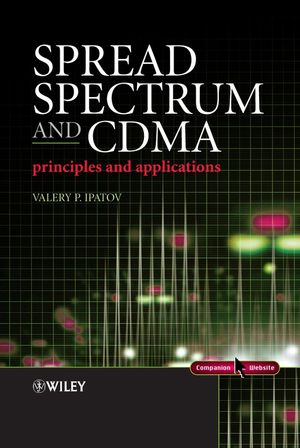|
Textbook
Spread Spectrum and CDMA: Principles and ApplicationsISBN: 978-0-470-09178-4
Hardcover
400 pages
May 2005, ©2005
 This is a Print-on-Demand title. It will be printed specifically to fill your order. Please allow an additional 10-15 days delivery time. The book is not returnable.
|
||||||
1 Spread spectrum signals and systems.
1.1 Basic definition.
1.2 Historical sketch.
2 Classical reception problems and signal design.
2.1 Gaussian channel, general reception problem and optimal decision rules.
2.2 Binary data transmission (deterministic signals).
2.3 M-ary data transmission: deterministic signals.
2.4 Complex envelope of a bandpass signal.
2.5 M-ary data transmission: noncoherent signals.
2.6 Trade-off between orthogonal-coding gain and bandwidth.
2.7 Examples of orthogonal signal sets.
2.8 Signal parameter estimation.
2.9 Amplitude estimation.
2.10 Phase estimation.
2.11 Autocorrelation function and matched filter response.
2.12 Estimation of the bandpass signal time delay.
2.13 Estimation of carrier frequency.
2.14 Simultaneous estimation of time delay and frequency.
2.15 Signal resolution.
2.16 Summary.
Problems.
3 Merits of spread spectrum.
3.1 Jamming immunity.
3.2 Low probability of detection.
3.3 Signal structure secrecy.
3.4 Electromagnetic compatibility.
3.5 Propagation effects in wireless systems.
3.6 Diversity.
3.7 Multipath diversity and RAKE receiver.
Problems.
4 Multiuser environment: code division multiple access.
4.1 Multiuser systems and the multiple access problem.
4.2 Frequency division multiple access.
4.3 Time division multiple access.
4.4 Synchronous code division multiple access.
4.5 Asynchronous CDMA.
4.6 Asynchronous CDMA in the cellular networks.
Problems.
5 Discrete spread spectrum signals.
5.1 Spread spectrum modulation.
5.2 General model and categorization of discrete signals.
5.3 Correlation functions of APSK signals.
5.4 Calculating correlation functions of code sequences.
5.5 Correlation functions of FSK signals.
5.6 Processing gain of discrete signals.
Problems.
6 Spread spectrum signals for time measurement, synchronization and time-resolution.
6.1 Demands on ACF: revisited.
6.2 Signals with continuous frequency modulation.
6.3 Criterion of good aperiodic ACF of APSK signals.
6.4 Optimization of aperiodic PSK signals.
6.5 Perfect periodic ACF: minimax binary sequences.
6.6 Initial knowledge on finite fields and linear sequences.
6.7 Periodic ACF of m-sequences.
6.8 More about finite fields.
6.9 Legendre sequences.
6.10 Binary codes with good aperiodic ACF: revisited.
6.11 Sequences with perfect periodic ACF.
6.12 Suppression of sidelobes along the delay axis.
6.13 FSK signals with optimal aperiodic ACF.
Problems.
7 Spread spectrum signature ensembles for CDMA applications.
7.1 Data transmission via spread spectrum.
7.2 Designing signature ensembles for synchronous DS CDMA.
7.3 Approaches to designing signature ensembles for asynchronous DS CDMA.
7.4 Time-offset signatures for asynchronous CDMA.
7.5 Examples of minimax signature ensembles.
Problems.
8 DS spread spectrum signal acquisition and tracking.
8.1 Acquisition and tracking procedures.
8.2 Serial search.
8.3 Acquisition acceleration techniques.
8.4 Code tracking.
Problems.
9 Channel coding in spread spectrum systems.
9.1 Preliminary notes and terminology.
9.2 Error-detecting block codes.
9.3 Convolutional codes.
9.4 Turbo codes.
9.5 Channel interleaving.
Problems.
10 Some advancements in spread spectrum systems development.
10.1 Multiuser reception and suppressing MAI.
10.2 Multicarrier modulation and OFDM.
10.3 Transmit diversity and space–time coding in CDMA systems.
Problems.
11 Examples of operational wireless spread spectrum systems.
11.1 Preliminary remarks.
11.2 Global positioning system.
11.3 Air interfaces cdmaOne (IS-95) and cdma2000.
11.4 Air interface UMTS.
References.
Index.



